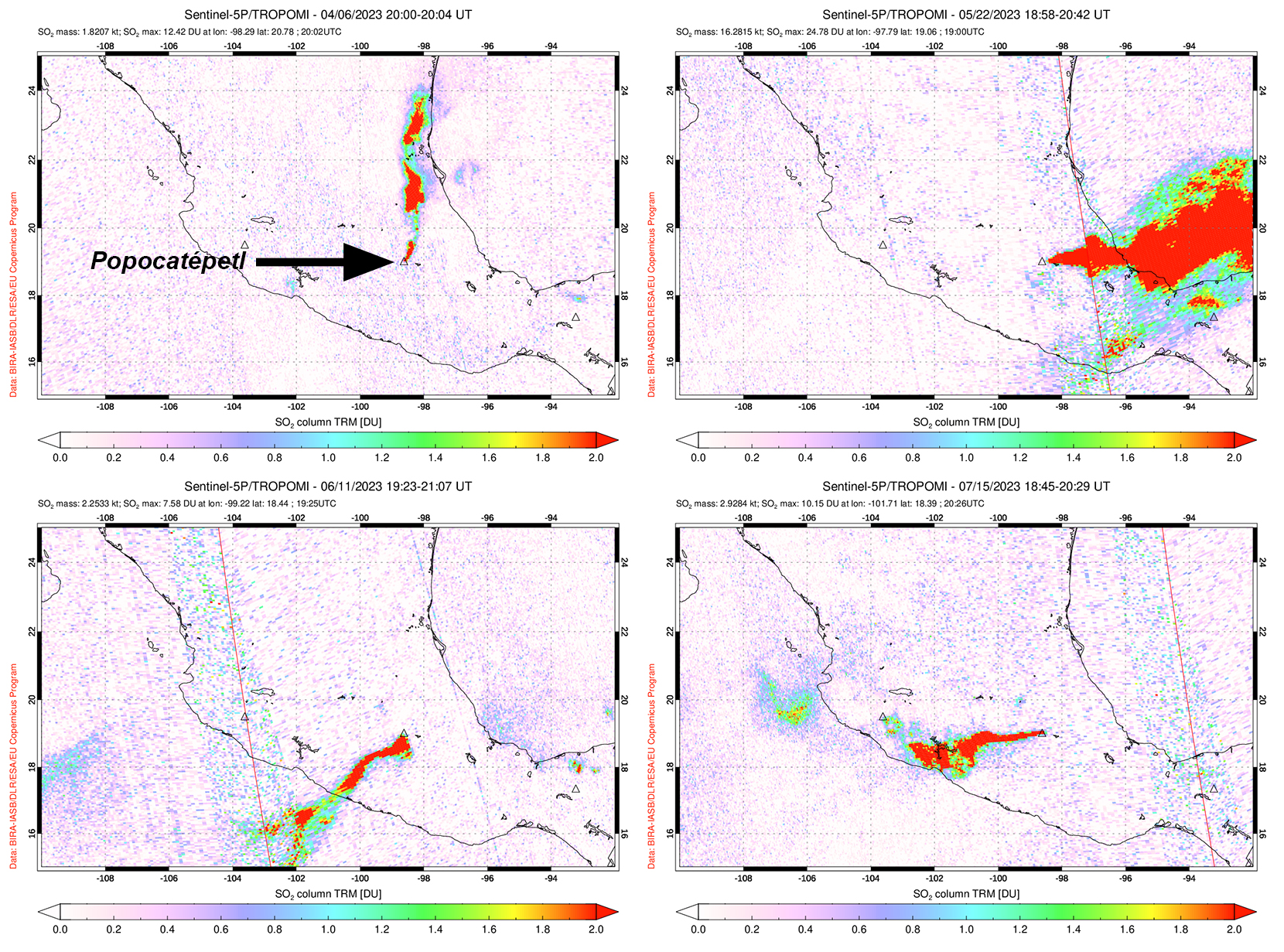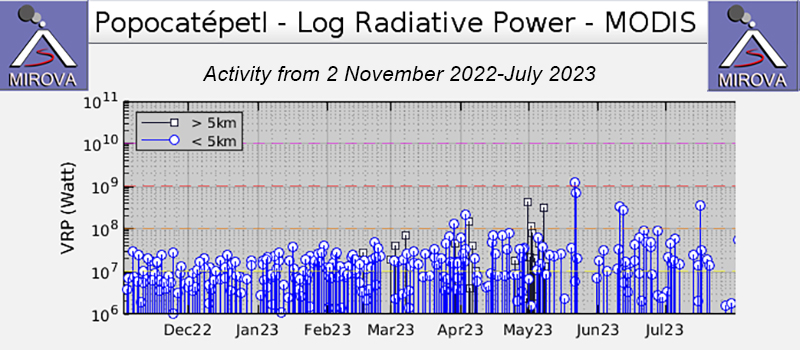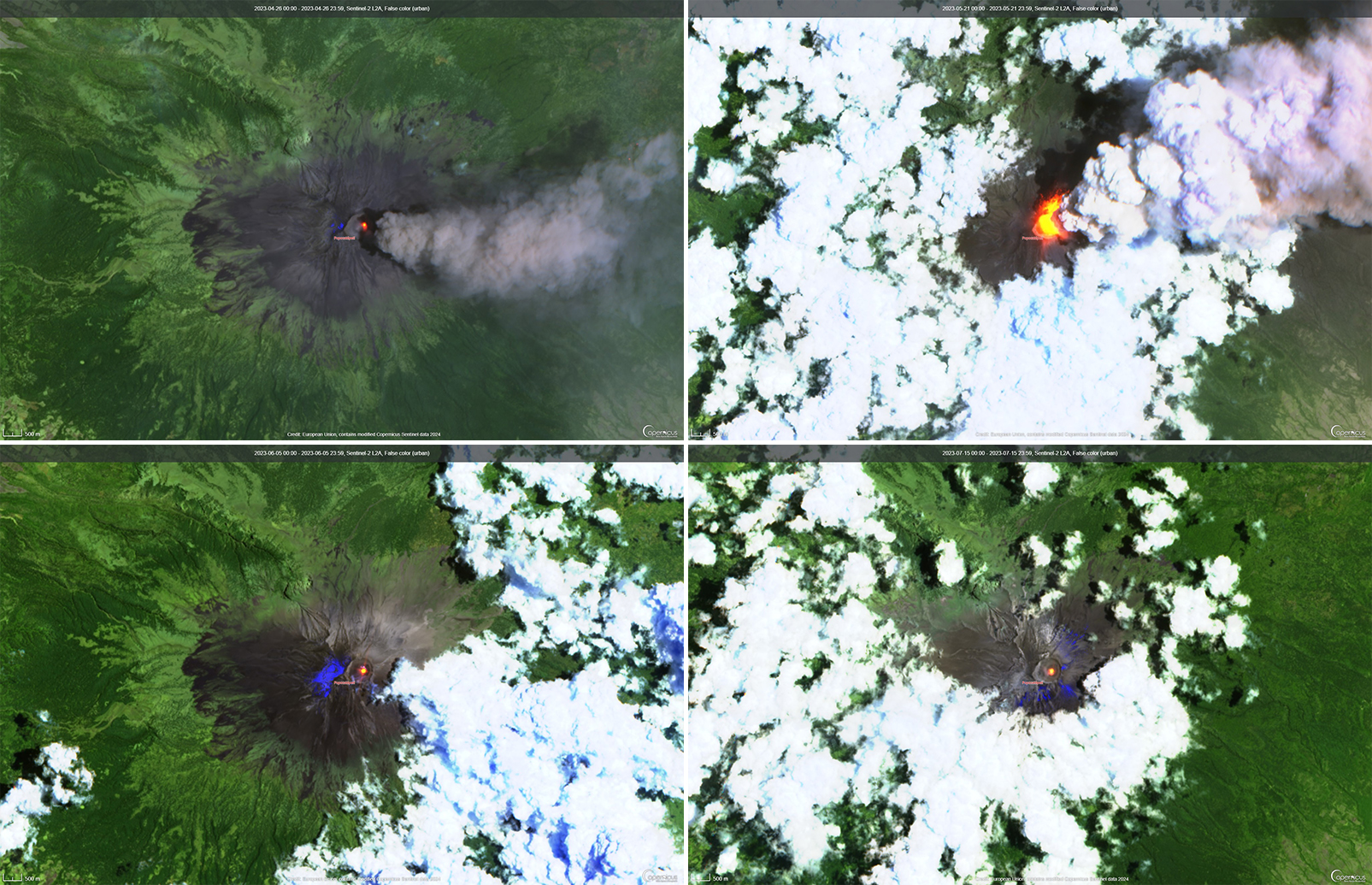Report on Popocatepetl (Mexico) — September 2023
Bulletin of the Global Volcanism Network, vol. 48, no. 9 (September 2023)
Managing Editor: Benjamin Andrews.
Edited by Kadie L. Bennis.
Popocatepetl (Mexico) Daily gas-and-ash emissions, ashfall, and explosions during April-July 2023
Please cite this report as:
Global Volcanism Program, 2023. Report on Popocatepetl (Mexico) (Bennis, K.L., and Andrews, B., eds.). Bulletin of the Global Volcanism Network, 48:9. Smithsonian Institution.
Popocatepetl
Mexico
19.023°N, 98.622°W; summit elev. 5393 m
All times are local (unless otherwise noted)
Popocatépetl, located 70 km SE of Mexico City, Mexico, contains a 400 x 600 m-wide summit crater. Records of activity date back to the 14th century; three major Plinian eruptions, the most recent of which took place about 800 CE, have occurred since the mid-Holocene, accompanied by pyroclastic flows and voluminous lahars that swept basins below the volcano. The current eruption period began in January 2005, characterized by numerous episodes of lava dome growth and destruction within the summit crater. Recent activity has consisted of daily gas-and-ash emissions, explosions, and ashfall (BGVN 48:04). This report updates activity during April through July 2023, which consisted of similar activity, according to daily reports from México's Centro Nacional de Prevención de Desastres (CENAPRED) and various satellite data.
Daily gas-and-steam emissions, containing some amount of ash, persisted during April through July 2023. CENAPRED reported the number of low-intensity gas-and-ash emissions or “exhalations” and the minutes of tremor, which sometimes included harmonic tremor in their daily reports (figure 213). A total of 36 volcano-tectonic (VT) tremors were detected throughout the reporting period. The average number of exhalations was 104 per day, with a maximum number of 315 on 31 May 2023. Frequent sulfur dioxide plumes that exceeded two Dobson Units (DU) and drifted in multiple directions were visible in satellite data from the TROPOMI instrument on the Sentinel-5P satellite (figure 214).
Activity during April consisted of gas-and-steam and ash emissions, with 139 explosions and six VT-type events detected. An average number of 169 exhalations occurred each day, which mostly consisted of water vapor, volcanic gases, and a small amount of ash. On most days, webcam images showed nighttime crater incandescence and incandescent material that was deposited on the upper flanks. Two large explosions at 0256 and 0342 on 3 April ejected material 2.4 km from the crater. Light ashfall was reported in Amecameca (20 km NW). On 12 April at 0353 a moderate explosion ejected material 1.5-2 km onto the S flank. Light ashfall was reported in Tochimilco (16 km SSE) and Atlixco (25 km SE) on 20 April and in Atlautla (16 km W), Tlalmanalco (27 km NW), San Pedro Benito Juárez and Atlixco on 21 April. Explosions at 0533 (figure 215) and 0559 on 21 April ejected incandescent material on the slopes as far as 2.3 km N from the crater. A moderate explosion at 0109 on 26 April ejected material on the N flank 1 km from the crater and at 0116 on 27 April ejected incandescent material was deposited onto the upper flanks. According to the Washington VAAC, ash plumes identified in daily satellite images rose to 5.8-7.3 km altitude and drifted NE, E, and SE.
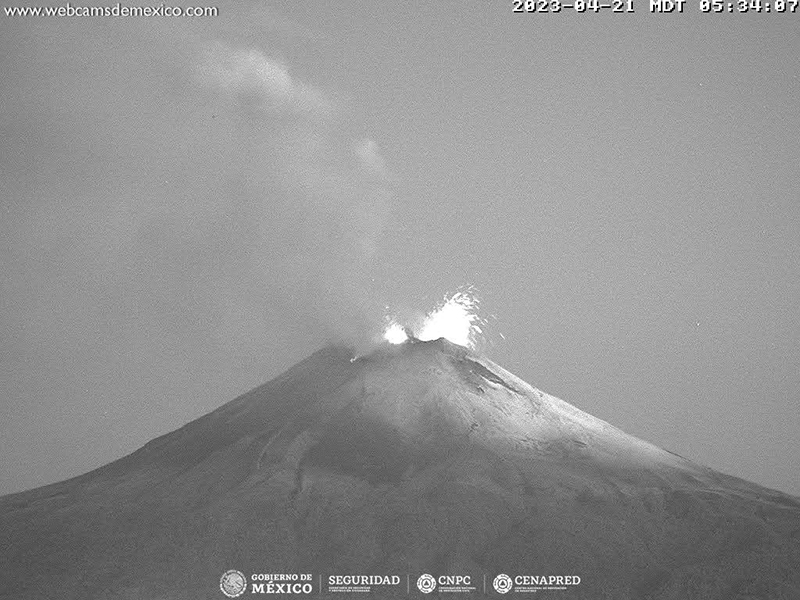 |
Figure 215. Webcam image of an explosion at Popocatépetl at 0534 on 21 April 2023. Incandescent material was deposited on the upper flanks to the N. Courtesy of CENAPRED daily report. |
During May there was an average of 131 exhalations each day, and a monthly total of 5 VT-type events, and 123 explosions, 85 of which were minor explosions and 37 were described as moderate. According to the Washington VAAC, daily ash plumes were identified in satellite images that rose to 6.1-7.3 km altitude and drifted E and SE. The National Center for Communications and Civil Protection Operations (CENACOM) reported light ashfall in Ozumba (18 km W), Tlalmanalco, and Temamatla (33 km NW) on 5 May and in Amecameca, Ayapango (24 km WNW), Temamatla, Tenango del Aire (29 km NW), Tlalmanalco, Tepetlixpa (20 km W), and Cocotitlán (34 km NW) on 6 May; moderate ashfall was reported in Tlalmanalco and Tenango del Aire. On 15 May light ashfall was reported in Puebla (43 km E) and Atlixco and moderate ashfall was reported in areas S of the volcano. CENAPRED reported that activity intensified during mid-May after the formation of small-to-medium lava domes on the summit crater floor, followed by their destruction. Periods of high-frequency tremor lasted more than 12 hours during 16-17 May and more than 10 hours during 17-18 May.
During the morning of 17 May CENACOM reported light ashfall in Puebla, Atlixco, Cholula (35 km E), and San Martín Texmelucan (35 km NE) and in Atlixco and Cholula during the morning of 18 May. Light ashfall was reported in Tétela del Volcán (20 km SW) during the morning of 19 May. A period of high-frequency tremor began around 1800 on 19 May and lasted roughly 10 hours until about 0400 on 20 May and was accompanied by gas-and-steam and ash plumes that drifted NNW. Continuous incandescent ejecta was deposited onto the flanks as far as 1.5 km from the crater.
According to CENACOM on 20 May the Benito Juárez International Airport closed during 04300-1000 and the Felipe Ángeles International Airport closed during 0600-1100 so that ash could be cleared from the runways. Ash was deposited in multiple areas downwind including in the municipalities: Tétela del Volcán, Venustiano Carranza (66 km NW), Gustavo A. Madero (73 km NW), Azcapotzalco (78 km NW), Tlalpan (62 km NW), Iztapalapa (58 km NW), Zumpango, Tlalmanalco, Ecatepec, Chicoloapan (48 km NW), Amecameca, Ayapango, Ozumba, Ecatzingo (15 km SW), Atlautla, Chalco (38 km NW), Temamatla, Tenango del Aire, Juchitepec (28 km NW), Cocotitlán, Tepetlixpa, Tonanitla, Tecámac, Jaltenco, Chiconcuac, Acolman, Valle de Chalco (44 km NW), Iztapaluca, La Paz (50 km NW), and Nezahualcóyotl (56 km NW). Ashfall in Puebla municipalities included Huejotzingo (28 km NE), Nealtican (21 km E), Chignahuapan (108 km NE), Puebla Capital (44 km E), San Martín Texmelucan (35 km NE), and San Felipe Teotlalcingo (26 km NE).
Almost 19 hours of high-frequency tremor recorded during 20-21 May was accompanied by continuous gas-and-steam and ash emissions and occasional incandescent ejecta deposited short distances onto the flanks. According to the Washington VAAC, activity intensified at 1453 on 20 May due to a large, dense ash plume that was observed in webcam images (figure 216). By 1551 the ash plume was visible in satellite images and rose to 8.2 km altitude and at 2041 the ash plume rose to 9.1 km altitude and drifted ENE over the Gulf of Mexico. At 2136 the ash plume rose to 9.7 km altitude and remained at that altitude at least through 0341 on 21 May, drifting NE and ENE. High-frequency tremor was almost constant for over 23 hours during 21-22 May. Ash plumes at 0951 on 21 May rose to 9.1 km altitude and at 1436 ash plumes rose to 8.5 k altitude. Satellite images showed a large, dense ash plume that drifted 388 km NE over the Bay of Campeche. According to CENAPRED, on 21 May the Alert Level was raised from Yellow, Phase 2 to Yellow, Phase 3, the highest of the three sub-phases. Ashfall was reported in San Andrés Cholula (36 km E), San Pedro Cholula (34 km E), Cuautlancingo (38 km E), Amozoc (61 km E), Puebla Capital (44 km E), Zacatlán (121 km NE), Tetela de Ocampo (121 km NE), and Chignahuapan (108 km NE).
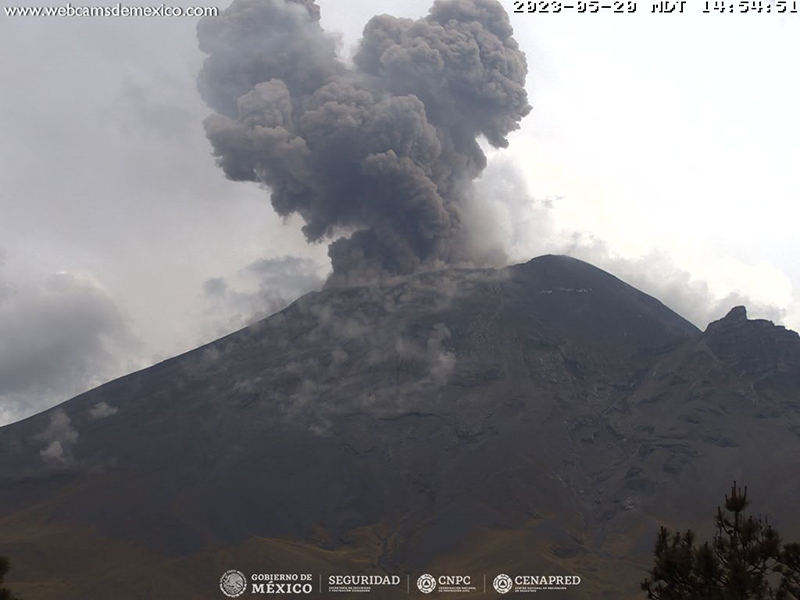 |
Figure 216. Webcam image showing a strong ash plume rising above Popocatépetl at 1454 on 20 May 2023. Courtesy of CENAPRED daily report. |
According to Gobierno de Puebla, the Hermanos Serdán International Airport in Puebla closed at 2300 on 21 May until 0700 on 22 May. The Washington VAAC reported that during the early morning of 22 May continuing ash emissions rose to 3.7 km above the summit and drifted E and ENE. An accompanying notable sulfur dioxide plume (figure 214) drifted as far as Cancun (1,295 km E). Ashfall was reported in San Andrés Cholula, San Pedro Cholula, Cuautlancingo, Amozoc, Zacatlán, Tetela de Ocampo, San Nicolás de los Ranchos (15 km NE), Palmar de Bravo (115 km SE), Tepeaca (76 km E), Izúcar de Matamoros (51 km S), Epatlán (51 km SE), Teopantlán (52 km SE), Tlapacoy (144 km NE), Huatlatlauca Chignahuapan (72 km SE), Juchitepec, Hueyapan (17 km SW), Xochitepec, and Tlaxcala. At 1651 on 22 May the Hermanos Serdán International Airport suspended operations because of ash on the runway. During 22-23 May tremor remained nearly continuous for more than 20 hours. On 23 May CENACOM reported ashfall in Nealtican, Tianguismanalco (22 km SE), Atlixco, San Diego la Mesa (39 km SE), Huaquechula (30 km SE), and Atzizihuacán (23 km S). Ash plumes rose as high as 3.7 km above the summit and drifted E, according to the Washington VAAC.
Continuous ash emissions rose to 7.6-10.7 km altitude and drifted SE, S, and SSE during 24-25 May, based on data from the Washington VAAC. Ashfall was reported in Nealtican, San Pedro Cholula, San Andrés Cholula, Tzicatlacoyan (65 km E), Tianguismanalco, Atlixco, Huaquechula, Ocoyucan (33 km SE), San Diego La Mesa Tochimiltzingo (39 km SE), San Juan Atzompa (71 km SE), Tehuitzingo (85 km SE), Tepexi de Rodríguez (88 km SE), Atzitzihuacán (23 km S), and Tilapa (48 km S). At 0045 on 25 May light ashfall was recorded in Atlixco, San Pedro Cholula, and Puebla Capital and at 0600 light ashfall was recorded in Tetela del Volcán. Incandescent material was ejected onto the flanks close to the crater on 25 May. A drone overflight conducted on 25 May showed that ash and incandescent material had significantly filled the inner crater. Air quality alerts were issued in Puebla and there was a reported increase in illnesses relating to ash exposure.
During 26-30 May gas-and-steam and ash rose to 5.2-7.9 km altitude and drifted SE, E, and ESE, according to the Washington VAAC. At 0330 on 26 May light ashfall was recorded in Tetela del Volcán. Later that day, ashfall was recorded in Hueyapan, Tetela del Volcán, Cuautla (43 km SW), Jantetelco, Jonacatepec (43 km SW), Tlacotepec (110 km SE), Atzitzihuacán, Chietla (56 km S), Huaquechula, Tlapanalá (39 km SE), Tepeojuma (39 km SE), and Nopalucan (87 km NE). On 27 May ashfall was recorded in Jonacatepec de Leandro Valle (43 km SSW), Tepalcingo, Yecapixtla (30 km SW), Zacualpan de Amilpas (32 km SSW), Hueyapan, Jantetelco, Ecatzingo, and Tenango del Aire. On 29 May light ashfall was reported in Ecatzingo, Tetela del Volcán, Hueyapan, Morelos, Nopalucan, Puebla Capital, San Andrés Cholula, Cuautlancingo, Amozoc, San Pedro Benito Juárez, and Tianguismanalco. Light ashfall was reported during 30-31 May in Ayapango and Acatzingo.
An average of 70 exhalations consisting of gas-and-steam and ash emissions were reported each day during June. Seismicity was characterized by a monthly total of 12 VT-type events. There were 31 explosions were recorded, 18 of which were described as minor explosions and 13 were described as moderate explosions. According to the Washington VAAC frequent ash plumes rose to 5.5-7 km altitude and drifted SW, SSW, SE, SSE, S, and W. On 6 June the Alert Level was lowered to Yellow, Phase 2 (the middle level on the three-color scale).
On 12 June light ashfall was reported in Hueyapan, Tetela del Volcán, Temoac (32 km SSW), Zacualpan de Amilpas, Jonacatepec de Leandro Valle, and Morelos, on 13 June in Hueyapan, Yecapixtla, Ayala, Jantetelco, and Morelos, on 14 June ashfall in Jantetelco and Morelos, on 15 June light in Hueyapan, Tetela del Volcán, Yecapixtla, Ayala, Amecameca, and Atlautla, and on 16 June in Amecameca, Ayapango, Chalco, Ecatzingo, Temamatla, Tepetlixpa, Tlalmanalco, and Tenango del Aire. On 17 June CENAPRED noted a moderate explosion at 0337 ejected material as far as 2.5 km from the crater. That same day, light ashfall was reported in Ixtapaluca (60 km NNW), Valle de Chalco, La Paz, Nezahualcóyotl, Amecameca, Atlautla, Ayapango, Cocotitlan, Chalco, Ecatzingo, Temamatla, Tenango del Aire, Tepetlixpa, and Tlalmanalco. Light ashfall was observed in Tepoztlan (49 km W), Cuernavaca (63 km WSW), Ocuituco (24 km SW), Cuautla (43 km SW), Atlatlahucan, Jiutepec (59 km SW), Emiliano Zapata (62 km SW), Morelos, Ixtapaluca, La Paz, Chalco Valley, Nezahualcóyotl, Chicoloapan, Atlautla, Ecatzingo, and Tonatico on 19 June, in Atlatlahucan, Morelos, Ozumba, Tenango del Aire, Tepetlixpa, Juchitepec, and Ixtapan on 20 June, and in Cuernavaca on 21 June. Small bursts of incandescent ejecta from the crater were visible during the night of 20 June. At 0312 on 22 June a moderate explosion ejected incandescent material as far as 1.5 km from the crater and generated an ash plume that rose 2 km above the crater. On 22 June light ashfall was reported in Hueyapan and Morelos. Two minor explosions at 0405 and 0745 on 23 June generated ash plumes that rose 500 m above the crater and incandescent material was ejected short distances from the crater. Moderate ashfall was reported in Ozumba, Juchitepec, and Tepetlixpa on 26 June. Ashfall was reported in Amecameca and Ayapango on 27 June. At 0850 on 28 June CENACOM reported light ashfall in Ixtapaluca, Valle de Chalco, and Nezahualcóyotl and at 1927 light ashfall was reported in Amecameca de Juárez, Ozumba, and Temamatla and moderate ashfall in Tenango del Aire. On 30 June light ashfall was observed in Atlautla, Chalco, and Telalmanalco, and moderate ashfall was observed in Amecameca and Cocotitlan.
Similar activity continued during July with an average of 47 exhalations each day, and a monthly total of 13 VT-type events and 31 explosions. There were 17 minor explosions and 14 moderate explosions recorded throughout the month. Daily ash plumes were reported by the Washington VAAC, based on webcam and satellite images; plumes rose as high as 2.2 km above the summit and drifted NE, SW, W, and NW. Two moderate explosions recorded during 1-2 July produced a gas-and-ash plume that rose 1.6 km above the crater and drifted SSW, SW, WSW, and NW (figure 217). CENACOM reported light ashfall in Ixtapaluca and Valle de Chalco on 1 July and in Atlautla, Ecatzingo, Yecapixtla, Ocuituco, Tetela del Volcán, Hueyapan, Cuautla, and Ayala on 2 July. During 2-3 July gas-and-ash plumes rose 1.3 km above the crater and drifted SW and W. An ash plume at 0843 on 10 July rose 1 km above the summit and drifted as far as 28 km NW. and at 0930 CENACOM reported light ashfall in Amecameca, Ayapango, Temamatla, and Tenango del Aire. By noon, the plume had drifted 185 km NW and the Secretaría de Gestión Integral de Riesgos y Protección Civil (SGIRPC) of the City of México reported ashfall in Milpa Alta (46 km WNW), Xochimilco (56 km WNW), Coyoacán (65 km WNW), Tlalpan, La Magdalena Contreras (70 km WNW), Álvaro Obregón (72 km WNW), Cuajimalpa (80 km WNW), Tláhuac (49 km NW), and Iztapalapa. At 0850 on 11 July CENACOM reported light ashfall in Ozumba and Juchitepec. Light ashfall was reported in Valle de Chalco, Ixtapaluca, La Paz, Nezahualcóyotl, Amecameca, Atlautla, Ayapango, Cocotitlán, Temamatla, Tepetlixpa, Tenango del Aire, Juchitepec, Chapultepec (100 km WNW), Calimaya (108 km W), Milpa Alta (46 km WNW), Tláhuac (49 km NW), Iztapalapa, and Tlalpan on 13 July and in Valle de Chalco, Amecameca, Ayapango, Atlautla, and Tenango del Aire on 14 July. On 23 July moderate ashfall was reported in Ozumba, Atlautla, Chalco, Cocotitlán, Tenango del Aire, and Temamatla. Light ashfall was observed during the morning of 25 July in Amecameca, Ayapango, and Tenango del Aire.
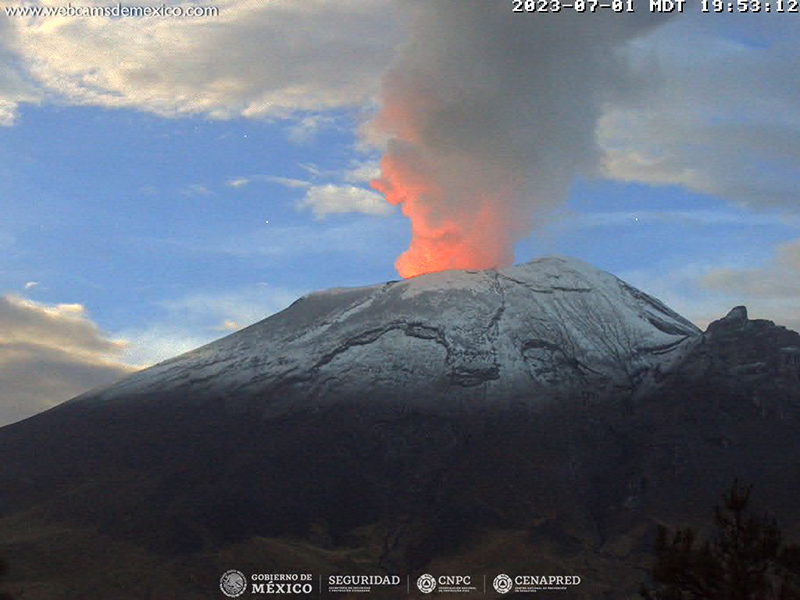 |
Figure 217. Webcam image of a gas-and-ash plume rising above Popocatépetl at 1953 on 1 July 2023. Courtesy of CENAPRED daily report. |
MODIS thermal anomaly data provided through MIROVA (Middle InfraRed Observation of Volcanic Activity) showed frequent low-to-moderate thermal anomalies during the reporting period; intermittent and short breaks in activity were visible during late May, early June, and mid-July (figure 218). A strong thermal anomaly was detected in mid-May. According to data from MODVOLC thermal alerts, a total of 38 hotspots were detected at the summit crater in April (3, 4, 6, 14, 15, 28, 29, and 30), May (2, 5, 10, and 22), June (3, 10, 15, 17, 19, 21, 22, 24, and 27), and July (5 and 16). Thermal activity in the summit crater was also visible in infrared satellite data and was sometimes accompanied by ash plumes, as shown on 26 April and 21 May (figure 219).
Geological Summary. Volcán Popocatépetl, whose name is the Aztec word for smoking mountain, rises 70 km SE of Mexico City to form North America's 2nd-highest volcano. The glacier-clad stratovolcano contains a steep-walled, 400 x 600 m wide crater. The generally symmetrical volcano is modified by the sharp-peaked Ventorrillo on the NW, a remnant of an earlier volcano. At least three previous major cones were destroyed by gravitational failure during the Pleistocene, producing massive debris-avalanche deposits covering broad areas to the south. The modern volcano was constructed south of the late-Pleistocene to Holocene El Fraile cone. Three major Plinian eruptions, the most recent of which took place about 800 CE, have occurred since the mid-Holocene, accompanied by pyroclastic flows and voluminous lahars that swept basins below the volcano. Frequent historical eruptions, first recorded in Aztec codices, have occurred since Pre-Columbian time.
Information Contacts: Centro Nacional de Prevención de Desastres (CENAPRED), Av. Delfín Madrigal No.665. Coyoacan, México D.F. 04360, México (URL: http://www.cenapred.unam.mx/, Daily Report Archive https://www.gob.mx/cenapred/archivo/articulos); Secretaría de Gestión Integral de Riesgos y Protección Civil (SGIRPC), 18 norte 406, Col. Barrio los Remedios Puebla, Pue. C.P. 72377, México (URL: https://sg.puebla.gob.mx/); Washington Volcanic Ash Advisory Center (VAAC), Satellite Analysis Branch (SAB), NOAA/NESDIS OSPO, NOAA Science Center Room 401, 5200 Auth Rd, Camp Springs, MD 20746, USA (URL: www.ospo.noaa.gov/Products/atmosphere/vaac, archive at: http://www.ssd.noaa.gov/VAAC/archive.html); MIROVA (Middle InfraRed Observation of Volcanic Activity), a collaborative project between the Universities of Turin and Florence (Italy) supported by the Centre for Volcanic Risk of the Italian Civil Protection Department (URL: http://www.mirovaweb.it/); Hawai'i Institute of Geophysics and Planetology (HIGP) - MODVOLC Thermal Alerts System, School of Ocean and Earth Science and Technology (SOEST), Univ. of Hawai'i, 2525 Correa Road, Honolulu, HI 96822, USA (URL: http://modis.higp.hawaii.edu/); NASA Global Sulfur Dioxide Monitoring Page, Atmospheric Chemistry and Dynamics Laboratory, NASA Goddard Space Flight Center (NASA/GSFC), 8800 Greenbelt Road, Goddard, Maryland, USA (URL: https://so2.gsfc.nasa.gov/); Copernicus Browser, Copernicus Data Space Ecosystem, European Space Agency (URL: https://dataspace.copernicus.eu/browser/).



